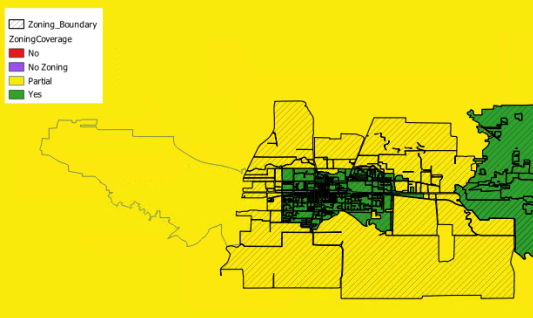- Print
- DarkLight
- PDF
Zoning FAQ
- Print
- DarkLight
- PDF
Q: Where can I find your zoning data coverage?
A: For each release, we will have a summary of data coverage in the release notes. You can find the detailed coverage information through the Zoning coverage map.
Q: How does LightBox handle zoning overlay conflicts?
A. Our methodology when processing zoning data is that we leave it true to the source. LightBox does not make any judgment call when an overlay conflict occurs. If you find a overlay conflict you should contact the zoning source which we provide.
Q: Why are there multiple records with the same PARCEL_LID in the zoning table?
A.1: It is possible for a single parcel to be governed by multiple zones. Most commonly, one of the zones is the base zoning code, and the others are zoning overlays.
A.2: A parcel can also be governed by multiple jurisdictions. Each jurisdiction may have their own zoning governance for the parcel.
In both cases above, you will see multiple zoning records with the same PARCEL_LID.
Q: How is INTERSECT_PCT field calculated?
A: INTERSECT_PCT is calculated by overlaying a parcel boundary with a zoning boundary from a jurisdiction and using the percent area that is covered by that boundary as the value.
Q: What to do if a jurisdiction needed is not yet covered in the dataset?
A: Our zoning coverage will expand overtime based on many factors, one such factor is that of client needs. When you sign on or renew your zoning data subscription, we encourage you to provide a list of jurisdictions (<20) that are most important to your business. Those requests are taken into consideration during our acquisition efforts.
- The zoning data is not available in a digital format.
- The jurisdiction does not release their zoning data in a consumable format.
- LightBox has yet to acquire that jurisdiction.
Q: Can I search for properties zoned for a specific type?
A: Once zoning data is linked to parcel via PARCEL_LID, users can search for parcels that meet a specific zoning criteria from the attributions we standardized.
Examples: ZONING_CATEGORY, FRONT_SETBACK_IN_FEET, PERMITTED_USES.
Q: What does the Zoning Category mean and how is it derived?
A: LightBox generates standardized zoning categories by analyzing keywords in the zoning description and zoning district fields.
Currently we have 12 zoning categories:
- Residential
- Commercial
- Industrial
- Agriculture
- Open Space/Parks
- Public
- Specific Purpose
- Planned Development
- Mixed Use
- Overlay
- Other
- Unknown
Q: Can I search for properties zoned for a specific type?
A: Once zoning data is linked to parcel via PARCEL_LID, users can search for parcels that meet a specific zoning criteria from the attributions we standardized.
Examples: ZONING_CATEGORY, FRONT_SETBACK_IN_FEET, PERMITTED_USES.
Q: What does ‘partial’ mean in the coverage map?
A: Zoning boundary data that we acquire for one jurisdiction often covers parts of neighboring jurisdictions as well.
In the example below, the zoning boundary file for the city in the center covers parts of the city on the left and county (surrounding area). In this case, the city on the left and county are both considered partial coverage.

Q: What projection or spatial reference is the Zoning Boundary and Zoning Coverage in?
A: The data is delivered in the WGS 1984 | EPSG: 4326
.png)

.png)